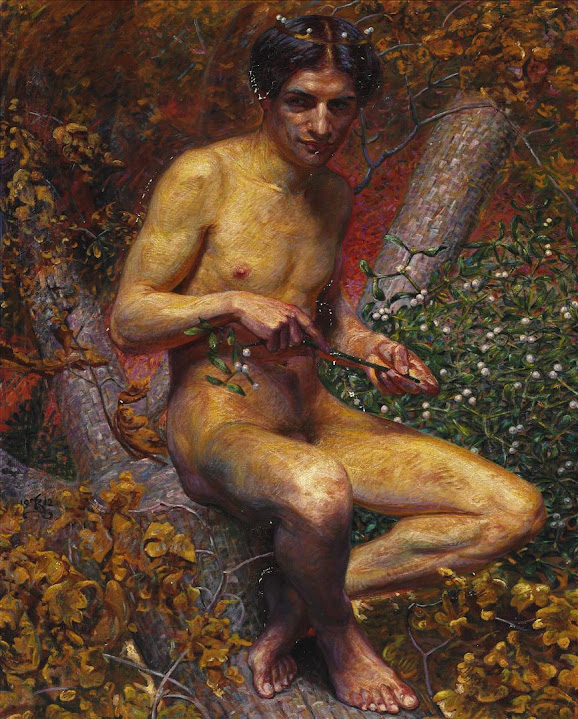Loki
Today we return to Norse mythology. The god Loki was a complex creature. He was known as a trickster. Sometimes he aided the other gods; sometimes he insulted them and opposed them. One gets the impression that this was not altogether a bad thing, and that sometimes the other gods needed someone to take them down a peg. However, Loki had a darker side and could be very malicious.
Loki was a shape-shifter and could transform into other creatures. His contradictory nature was even expressed sexually. Normally he was male, and he had a wife and son. But in one myth he transformed himself into a mare, had sex with a stallion, and then gave birth to a foal that became Odin's horse, Sleipnir. (Sleipnir had eight legs, but we won't get into that.) So, you might say that Loki was non-binary, centuries before that became a gender identity.
This 1912 painting of Loki is by Kristian Zahrtmann. Note the twig he's holding from the mistletoe plant behind him. You'll see the significance of it later.
Today we present two myths that express Loki's double-sided nature.
The first myth is about Baldur or Baldr, the son of the head god Odin and his wife Frigg. Everyone loved Baldur, and he was so good-looking that he was referred to as "shining" (above). Then both Baldur and his mother Frigg had a dream that he died. Fearing that this was a prophecy, Frigg made every object and plant and animal vow never to hurt Baldur. However, she forgot to ask the mistletoe.
(Baldur the Beautiful by Ludwig Fahrenkrog, 1908)
The gods then made a game of throwing things at Baldur, since nothing could hurt him. Somehow Loki found out about the mistletoe, and he made an arrow from its stem. Then he gave the arrow to Baldur's brother, the blind god Höðr, who shot it at Baldur, killing him.
The wooden bas-relief of Baldur's death, above, by Dagfin Werensiold, is part of the Yggdrasil Frieze at the Oslo Radhus (town hall). Note the mistletoe growing on the tree in the background
This time Loki had gone too far. This was no mere insult or trick. Loki was condemned to be bound, with a serpent perpetually dripping venom onto him. His wife Sigyn held a bowl to collect the venom and keep it off of him, but every now and then, she had to go empty the bowl, and then the venom fell on Loki and he writhed in pain, causing earthquakes.
(Loki's Punishment by Constantin Hansen, 1850s)
Loki's punishment was a favorite artistic subject for Nordic artists,. Unlike most art from the Norse myths, in which nudity is rare, Loki is almost always naked in depictions of his punishment.
(Loki's Punishment, statue by Ida Matton, 1923, outside the Stockholm City Hall)
But as I said earlier, Loki had a complex nature, and he wasn't all evil. His other side is shown in the story of Loki and the goat. In this myth, the gods had killed the giant Thjazi. The giant's daughter, Skadi, appeared and demanded reparation for her father's death.
As the first reparation, Odin turned her father's eyes into stars. The second reparation was to make her laugh again. None of the gods succeeded in making her laugh. Then the trickster, Loki, took a rope and tied one end of it to a goat and tied the other end around his testicles and proceeded to have a tug-of-war between his balls and the goat (I am not making this up). Needless to say, that made Skadi laugh.
Somehow, I doubt that we're going to see Tom Hiddleston acting out this myth in the movies.
(Loki vs the Goat by Thrandur Thorarinsson, 2012)
For the third reparation, Skadi demanded to choose one of the gods as a husband. The gods agreed, but on the condition that the eligible gods would stand behind a screen and Skadi must choose her husband by his feet. Skadi chose the one with the most beautiful feet, thinking that it was the beautiful god Baldur. But it turned out to be the sea god Njordr, whose feet had been constantly washed by the ocean.
(Photo: Maslin Beach Nude Olympics in Australia. A bit more than their feet was revealed – this was the Best Bums competition.)
Next time: a naked Christian myth.







3 comments:
very interesting
Loki became Loge in Wagner RING!
Never knew this backstory. Thanks!
Gee, myths can sure get complicated. Fun, nonetheless.
Post a Comment